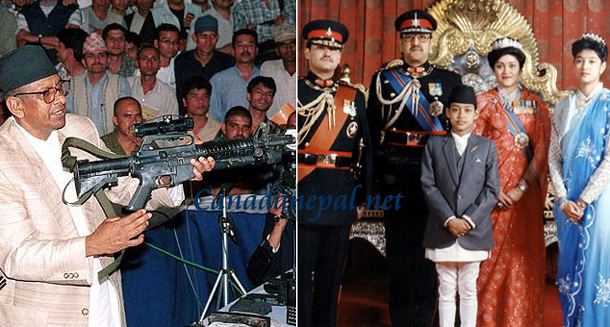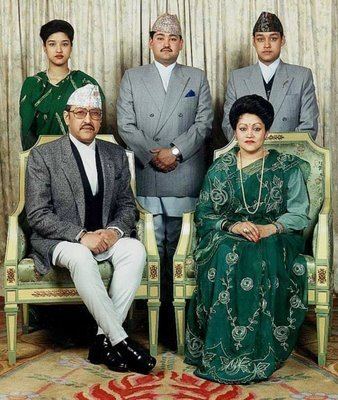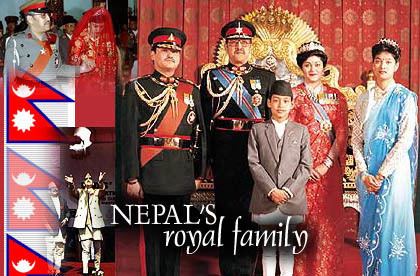Non-fatal injuries 5 | Date 1 June 2001 | |
 | ||
Target The Nepalese Royal FamilyKing Birendra of Nepal Total number of deaths 10 (including the perpetrator) | ||
The Nepalese Royal Massacre occurred on 1 June 2001, at a house on the grounds of the Narayanhity Royal Palace, the residence of the Nepalese monarchy. Ten members of the family were killed during a party or monthly reunion dinner of the royal family in the house. The dead included King Birendra of Nepal and Queen Aishwarya.
Contents
- Overview of events
- Killed
- Wounded
- Aftermath
- Rumours regarding cause of massacre
- Ceremonial response
- Conspiracy theories
- References

Later, upon his father's death, Prince Dipendra became de jure King of Nepal while in coma, and he died in the hospital three days after the massacre without recovering from this coma.

Birendra's brother Gyanendra became king after the massacre and the death of King Dipendra.
Overview of events
According to reports, at the dinner, Crown Prince Dipendra had been drinking heavily, had smoked large quantities of hashish and "misbehaved" with a guest which resulted in his father King Birendra telling Dipendra, who was his oldest son, to leave the party. Crown Prince Dipendra was escorted to his room by his brother Prince Nirajan and cousin Prince Paras.
About an hour later, Dipendra walked outside the party room and pulled a SPAS-12 from the bag containing the weapons, including an H&K MP5 submachine gun and an M16. He walked inside and fired a single shot with the SPAS-12, hitting his father, before firing into the ceiling. As the family began to aid King Birendra, Dipenra went outside, got the M16 from the bag, and returned to the room. He walked up to his father, who lay on the floor, and prepared to shoot him again. When his uncle Dhirendra tried to dissuade Dipendra from doing so, he shot his uncle in the chest at point-blank range. This was the beginning of the massacre. Dipendra aimed at Kumar Khadga, shooting him several times in the chest, killing him. His wife, Princess Sharada, ran over to her husband and began to cradle him. Dipendra then turned the gun on her and shot her multiple times in the back, killing her instantly.
Dipendra then shot Kumar Gorakha, hitting him in the face and hand. He fell onto the couch, groaning in pain. Princess Shruti, his wife, ran over to her husband, only to be fatally shot by her brother in the chest, falling on top of her husband. Excerpts from the official probe report, prepared by a two-member committee in Kathmandu, states that King Birendra made an abortive last-minute attempt to shoot at Dipendra as the latter fired indiscriminately at the royals. Dipendra had thrown the 9mm caliber MP5 automatic submachine gun into the billiards room, when he returned for a second time. The king managed to take hold of it, however, his sister Princess Shova Shahi snatched the weapon from him and pulled out the magazine of the gun assuming it to be the only weapon Dipendra had. Dipendra walked over to his aunt, raised the rifle, and shot her. Shova was hit nine times in the back, but survived. While this continued, Prince Paras suffered slight injuries and managed to save at least three royals, including two children, by pulling a sofa over them. The above version of the story is reportedly the one that Shova Shahi told the official committee. Corroborating Shova Shahi's version, Prince Paras is quoted as having said, "She [Shova] must have thought that it was the only weapon Dai (Dipendra) had but I saw that he had much more weapons."
Dipendra then laid his eyes on Princess Komal, who was sitting on a sofa next to Princess Shanti. He fired, hitting Komal once in the chest, but she survived. He then turned the gun on Shanti, hitting her once in the abdomen and killing her immediately. He now had his sights on Princess Jayanti and her younger sister, Ketaki Chester. When Jayanti tried to call for help on her cellphone, Dipendra shot her multiple times in the chest. He then shot Chester in the shoulder as she pleaded with him. Chester later remembered that Dipendra was making sure they were dead by looking for movement. When he returned to Chester, who had blood running down her face as she was laying on her side, he thought he had killed her. Chester survived, but her sister did not. Dipendra then turned to Paris, who was protecting the other family members. Paris told him that he had done enough, and Dipendra, never saying a word, walked out of the room.
As the story later told, the Queen Aishwarya, who came into the room when the first shots were fired, escaped the room following Dipendra to reason with him. She was accompanied in her pursuit by her younger son, Prince Nirajan. Nirajan was then shot in the chest, fatally, in the garden by the Crown Prince. His mother followed her son up to the top of the outside stairs, crying and asking Dipendra what he was trying to prove. Dipendra then turned, aimed the gun at his mother, who tried to run, but he fatally shot her multiple times in her nape and back. She fell, rolling down the steps. Dipendra proceeded to a small bridge over a stream running through the palace gardens, where he shot himself six times in the back and once in the left hand, which left him critically injured. The only major reason, to surface later, behind the massacre was a love and marriage issue Dipendra of Nepal was facing. It was his family's opposition to his marriage to Devyani Rana which angered and frustrated him. It was this petty love scandal that led to the downfall of a royal clan and the Nepalese Monarchy in all in the years to follow. His funeral was executed with full royal honours, one befitting a king but was however unattended by any family member.
Killed
Wounded
Aftermath
Dipendra was proclaimed king while in a coma, but he died on 4 June 2001, after a three-day reign. Gyanendra was appointed regent for the three days, then ascended the throne himself after Dipendra died.
While Dipendra lived, Gyanendra maintained that the deaths were the result of an "accidental discharge of an automatic weapon". However, he later said that he made this claim due to "legal and constitutional hurdles", since under the constitution, and by tradition, Dipendra could not have been charged with murder had he survived. A full investigation took place, and Crown Prince Dipendra was found to be responsible for the killing.
A two-man committee comprising Keshav Prasad Upadhaya, the Supreme Court Chief Justice, and Taranath Ranabhat, the Speaker of the House of Representatives, carried out the week-long investigation into the massacre. The investigation concluded, after interviewing more than a hundred people including eyewitnesses and palace officials, guards and staff, that Dipendra had carried out the massacre. A large number of critics and Nepalese, both inside Nepal and abroad, disputed the official report because many facts and evidence reported by the investigation team seemed contradictory in many aspects. A close aide of Dipendra when he was prince said of Dipendra, "He can give up the throne for the sake of his love, but he can never do this kind of thing."
Rumours regarding cause of massacre
The widely circulated rumour is that Prince Dipendra was angry over a marriage dispute. Dipendra's choice of bride was Devyani Rana, daughter of Pashupati SJB Rana, a member of the Rana clan, which the Shah dynasty have a historic animosity against. The Rana clan had served as the hereditary prime ministers of Nepal, with the title Maharaja, until 1951, and the two clans have a long history of inter-marriages. It is also speculated that the reason for the marriage dispute over Dipendra's choice of wife was that the royal family had a position that the crown prince should not marry someone having relatives in India, as Devyani did. Also, the fact that Devyani Rana's mother, Usharaje Scindia was of Gwalior royal lineage, wasn't considered impressive by the Nepal royal family. Prince Dipendra also courted Supriya Shah, who was the granddaughter of Queen Mother Ratna's own sister. Queen Aishwarya, though initially against the relationship due to family ties and the view that Supriya would be incompetent as a queen, as to which expressions by the Queen were heard by an aide, nevertheless favored Supriya over Devyani Rana, since if Supriya became Queen, the Shah dynasty would not have to share its power with the Ranas, entailing formation of an unwanted political alliance.
Ceremonial response
On 11 June 2001, a Hindu katto ceremony was held to exorcise or banish the spirit of the dead King from Nepal. A brahmin Durga Prasad Sapkota, dressed as Birendra to symbolise the late King, rode an elephant out of Kathmandu and into symbolic exile, taking many of the actual belongings of the King with him.
Conspiracy theories
Many Nepalese people are skeptical of the official report that the then Crown Prince Dipendra carried out the murder. King Birendra and his son Dipendra were very popular and well respected by the Nepalese population. Subsequently, Pushpa Kamal Dahal Prachanda, the chairman of the Nepalese Maoist Party, in a public gathering claimed that the massacre was planned by the Indian intelligence agency RAW or the American CIA. Promoters of these ideas allege Gyanendra had a hand in the massacre so that he could assume the throne himself. His ascension to the throne would only be possible if both of his nephews Dipendra and Nirajan were eliminated. Moreover, Gyanendra and especially his son Prince Paras were grossly unpopular with the public. On the day of the massacre he was in Pokhara whilst other royals were attending a dinner function. His wife Komal, Paras and daughter Prerana were in the room at the royal palace during the massacre. While the entire families of Birendra and Dipendra were wiped out, nobody in Gyanendra's family died: his son escaped with slight injuries, and his wife sustained a life-threatening bullet wound but survived.
Despite the fact that two survivors have publicly confirmed that Dipendra did the shooting, as was documented in a BBC documentary, the chain of events is disputed by some Nepalese. After the monarchy was abolished through a populist uprising there have been several claims refuting the official report, among them is a book published in Nepal named Raktakunda recounting the massacre. It looks at the incident through the eyes of one of the surviving witnesses, Queen Mother Ratna's personal maid, identified in the book as Shanta. The book, which the author says is a "historical novel", posits that two men masked as Crown Prince Dipendra fired the shots that led to the massacre. Shanta's husband, Trilochan Acharya, also a royal palace employee, was killed along with 10 royal family members, including the entire family of King Birendra. In addition to details of the royal massacre, Shanta alleged many other cover-ups by the royal family, including a claim that the previous king King Mahendra committed suicide.The then Prime minister of nepal said to international media that massacre to out due to the "accidental discharge of an automatic weapon".
